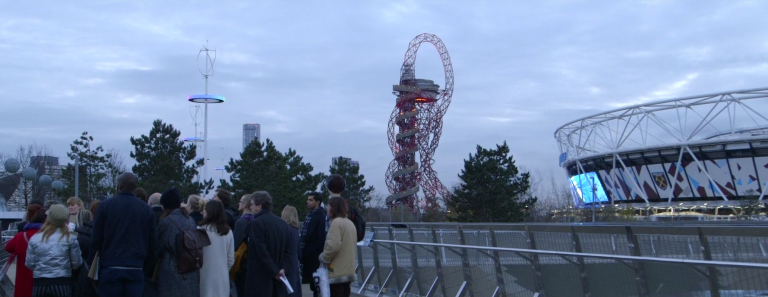Four artist:researcher commissions announced
18 June 2019
We are excited to announce the four commissioned partnerships between UCL researchers and east London artists to be part of an exhibition on the Queen Elizabeth Olympic Park in October 2019.

As part of the Trellis: Public Art programme, we are excited to announce the four artist:research partnerships that have been commissioned to make work for an exhibition in October 2019.
Funded by the Engineering and Physical Sciences Research Council (EPSRC) Trellis is a project exploring how to create opportunities for knowledge exchange between UCL researcher and east London artists.
For more information on the project as a whole you can watch this video playlist.
The partnerships are:
- Lucy Harrison (artist) working with Efstathia Kostopoulou (Bartlett School of Architecture)
Lucy Harrison and Efstathia Kostopoulou are investigating the past industrial history of the Park and exploring how this can be made more visible in the present. Using archive research and oral history interviews they are mapping the site and the history of the industries that were previously there, focussing on liquids (oil, paint, perfume, and syrups) and using the waterways as a navigation. They will investigate the materials and processes themselves as well as the memories of those who experienced them. Their collaboration will result in interventions on the site which will bring these industries back to the surface.
- Amanda Lwin (artist) working with Tse-Hui Teh (Bartlett School of Planning)
Dr. Tse-Hui Teh (Lecturer in Urban Design and Planning) and Dr. Lena Ciric (Senior Lecturer in Microbiology) are working with artist Amanda Lwin on a project that seeks to change people’s feelings about urine. As a society we’ve forgotten that urine is an incredible, free source of nitrogen – pee is regarded as a waste product and flushed down the drain, along with litres of drinking-quality water. Rather than consuming fossil fuels (in the production of ammonia) to fertilise our fields, while wasting both water and urine, the project proposes ways to celebrate urine as a useful, natural product linking our bodies to fertility, water infrastructure and the landscape.
The project involves the production of watering cans that double as (female) urinals which are, over the summer, distributed to allotment holders and community garden volunteers in the boroughs that surround the Olympic Park. In the autumn, the participants in the project gather at the Park to witness their vessels being festooned on a frame, which converts into a water fountain. A kind of temporary water fountain that disappears after two weeks, as the participants retrieve their vessels. The artwork becomes an ephemeral celebration of water, so essential to our cities yet so strangely invisible.
- David Rickard (artist) working with Tony Kenyon (Dept of Electrical and Electronic Engineering)
‘Beyond Sight Within Grasp’ is a collaborative project developed by Tony Kenyon, Professor of Nanoelectronic & Nanophotonic Materials at UCL, and the artist David Rickard for ‘Trellis Public Art’.
Nanotechnology is a relatively new field of research that was first established in the 1980’s following advances in microscope technologies. With one nanometre equal to one billionth of a metre, approximately 1/100,000 the width of a human hair, this remarkably small scale is considerably smaller than the wavelength of visible light. Therefore, things at a nanoscale are literally impossible to see with any optical microscope. Instead scientists build up images using a variety of tools such as the Atomic Force Microscopes (AFM) which measure movements in a very fine tip that gently hovers above, touches or taps the sample surface. Visualising matter at nanoscale is much like seeing in the dark, as we are all blind at this scale.
For Trellis Public Art we will be working in collaboration with London Vision East to engage with the local visually impaired community to create a new art work which considers our relationship to nanotechnology, whilst inverting the visual dominance typically found within public art by engaging touch as a primary mode of sensory perception.- Alison Turnbull (artist) working with Elsa Arcaute (Bartlett Centre for Advanced Spatial Analysis)
Alison Turnbull is a visual artist using found materials as starting points for the production of abstract paintings and drawings; Elsa Arcaute is a dancer and theoretical physicist working with processes in urban systems. Their collaboration is founded on a shared interest in pattern. Elsa studies the emergence of patterns from the perspective of complexity science and Alison uncovers the invisible from visual patterns.
For this project, Alison is responding to Elsa’s research into the fractal geometry of cities – London, in particular - in a series of drawings that become graphic scores; these, in turn, are interpreted through sound and movement. A process of conversion is taking place. Using methods of mapping, coding and transcription that, in very different ways, are common to both their practices, they are searching for means of transferring ideas from one realm to another.
Working with filmmaker Hugo Glendinning, this ‘fractal’ encounter between dance and drawing will be further explored in a film - or constellation of video sketches – in which London itself will have a leading role.
All parties were part of a matchmaking event in December 2018, which brought together researchers from UCL and artists based in or linked to east London and nine partnerships were funded for initial porject exploration. You can see more about the process on this playlist of videos:
For more information, contact the UCL Community Engagement (East) team.
 Close
Close

